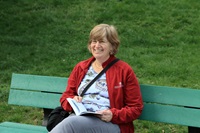Meet Lynne Helfand, the Lung Transplant Program’s social worker.
I was a paralegal for a while, thinking I would go to law school, but pretty quickly it became clear that it was not something I was interested in. And then my next job was a resource specialist at Beth Israel Hospital.How did you make the transition from resource specialist to social work?
As a resource specialist, I was working with a group of social workers finding resources for patients. I was meeting with patients, helping them figure out insurance, getting help in their homes, transportation and state and federal benefits. So I was in there working at that level—and I loved it. It was a natural fit for me, and from there, I got a degree in social work and a degree in public health at the same time. I loved the clinical work. I loved being in there with the patients.
Where did your social work career begin?
I worked in a clinical mental health center for about half the time, and the other half was crisis management. We managed crises, sometimes helping families get their family members to the hospital or emergency room. So that was my first job—a sort of trial by fire. It was tough but a great experience. From there, I returned to Beth Israel in the renal program, which I loved. Then I began working at Boston Children’s in the Cystic Fibrosis Center. That was my first job here 23 years ago. I still have some hours in that program, in addition to working for the Lung Transplant Program.
What attracted you to Boston Children’s?
I was attracted to the opportunity to work with parents, adolescents and young children. While I am managing very difficult and serious situations, there can be an element of play and fun with children.
Why is the role of the social worker so important to the transplant journey?
My job touches on a little bit of everything. I make sure they have the resources and support they need, bridging the gap between their medical needs and coping needs. As part of the evaluation, I am meeting with them at the same time as the medical team, making a decision whether this is the right treatment for them and if this is the right time for the treatment. If they are not going to be listed, I might stay in touch, but I am not primarily working with the families until they are listed on the transplant waiting list. At that point, I get pretty involved. Lung transplantation is an extensive journey. Patients need to be on top of their pre-transplant care to actually have successful outcomes post-transplant. A lot of our families have had a chronically ill child for a while. Some of them have relatively healthy children, so all of this is new. The other piece is to try to help families continue to live as full a life as possible while waiting for transplant.
What is unique about supporting teenage transplant patients?
It is a combination of guiding them through pre-transplant and also helping them to understand this is a process for them, and they are going to need medicine and care for the rest of their lives. Some teenagers in the Lung Transplant Program are cystic fibrosis patients, many of whom I have known forever. In general, they have already been managing a huge burden of care, so really my job is about helping them continue to prepare in the best way they can.
What are the challenges of working with transplant patients?
I think you get involved in people’s lives, and it’s great when things go well, but it’s very hard when they don’t. Whatever the experiences are, you want them to be the best they can be. That’s where I think the gratification is for me. Sometimes kids fly through transplant and sometimes they don’t, but you hope that the experience is that both the parents and the patient feel understood, taken care of, like they are part of a team in managing their care, and that they are respected in all ways.
What are you most proud of as it relates to your work?
I get the most gratification from being part of people’s very difficult journeys and providing support that helps them overcome obstacles. When they haven’t been able to ride a bike or go to school, and then post-transplant, they achieve these milestones for the first time in a long time or the first time ever—that makes me smile.
